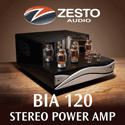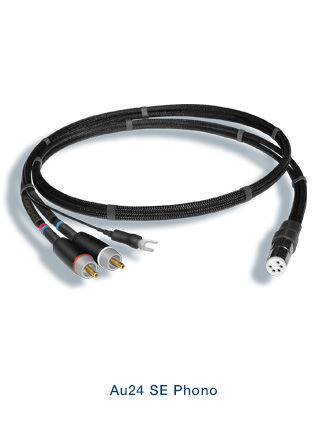|
|
You are reading the older HTML site
Positive Feedback ISSUE 75
audience av Au24 SE Phono Cables - Are All Phono Cables Created Equal? as reviewed by Myles B. Astor
To loom or
not to loom, that is the question— For the most part, analog devotees don't think twice about using interconnects as phono cables. But is that best method to obtaining the best sound from an analog front-end? If my recent experience is any indication, the answer is not necessarily. Why the sudden fascination or obsession with phono cables? The roots of my rethinking the importance of the phono cable within the analog playback chain are directly traceable to recent online conversations with Jonathan Carr, renowned Lyra cartridge as well as the highly respected Connoisseur electronics designer. In short, Jonathan has of late, been investigating and modeling the electrical interactions between the phono cartridge, phono cable and phono section (some similar but less involved graphs can also be found also at Hagtech.com). Jonathan's most intriguing findings, some of which are hinted at in the instructions accompanying the Atlas cartridge, include: 1) Moving coil cartridges are as sensitive to phono cable capacitance as moving magnet cartridges; 2) Cartridge loading really doesn't have much of an effect on frequency response within the audible range (that Jonathan concludes is good for phase response); 3) The electrical interaction between the phono cable and cartridge produces ultra high frequency peaks that can among things, overload phono sections; and 4) Utilize low capacitance phono cables to reduce both the amplitude and frequency of this peak and thus allow the use higher loading values. Coincidentally and independently, Audience too was thinking along the same lines and also investigating the interaction of the cartridge with the phono cable and phono section. Roger Sheker, the designer of Audience's phono cable, also concluded that the one size fits all approach doesn't work with interconnect and phono cables. Roger found that the variation in internal electrical properties among different phono cartridges makes choosing a cable ever-so-critical or precious low level detail information essential to the overall sonic presentation is easily lost. And that low level information often makes or breaks a high-end audio system. Background The Audience Au24 SE review was originally slated to run as part of a much larger phono cable survey. My ears and ambition, unfortunately, turned out to be larger than my resources and in the end, simply decided to review each of the phono cables on their own. First, a couple of quick notes about the phono cable break-in process. It's no secret to any dyed-in-the-wool analog person that phono cables (and tonearm wires for the matter) aren't—because of the cartridge's low output voltage—ever fully broken-in. So for the purposes of this review, the Audience phono cables (as well as the VPI 3D's internal tonearm wire) were broken-in using the Audiodharma Cable Cooker. (As a matter of policy, however, cable manufacturers are always contacted before using audiodharma.) Settling in after cooking, however, proved to be another story. Even allowing for burn-in, another 24 hours was needed for the phono cable(s) to sound their best. Part of this effect appears due to cables needing to lay undisturbed for a period of time before listening and part seems to be related to the final stages of break-in. Next, listening sessions began with my old VPI Reference Super Scoustmaster turntable with the rim drive and the Classic 10.5i arm; along the way, the VPI Classic Direct turntable and 3D arm entered the picture and replaced the Super Scoutmaster. In addition, a number of different moving coil cartridges were drafted into service in the course of this review including the Lyra Atlas, the Transfiguration Proteus and the Koetsu Azule Blue. On Sound Footing The Audience Au24 SE phono cables are exceedingly well balanced sounding and truly one of the best bangs for the buck out there in the analog world. While the cable's smoothness, quietness and transparency are instantly recognizable, it's in the areas of soundstaging and three-dimensionality and dynamics where the Au24se makes hay. Unlike some other cables, the Audience never shouts out, "hey, look (listen) at (to) me." No, these cables are just speak the musical truth and where they err is primarily on the side of omission. For example, take the great Rudy van Gelder recording Kenny Burrell Night Lights Vol. 2 (Blue Note/Classic Records 1597). When everything in the system, neighborhood, solar system and universe are in alignment, there's simply an uncanny reality and breadth to the timbre of Burrell's guitar with the Audience phono cable. Burrell's guitar simply comes to life and the music just swings. Tonally, the Audience just ever-so-slightly hangs onto the leading edge of the waveform and in the process loses just a smidge of low level detail (this is also heard on the Elvis '57 reissue from Analogue Productions). No, the Audience is not quite as fast sounding as say the very best silver cables or possess the sense of ease and transparency of the MIT Oracle. But in all fairness, we're comparing the Audience to some megabuck cables. As with all the great van Gelder recordings, the Audience phono cables recreate that eerie sense of palpability—not to mention the sense of musicians—performing in your room. The Au24se really combines outstanding soundstaging and imaging and has an uncanny ability to separate and place, for example, Tina Brook's sax and Louis Smith's trumpet in their own space. Where the Audience falls just a little short of ultimate is in its ability to recreate the last vestiges of the recording's airiness. Or try on for size Isao Suzuki Trios' Three Blind Mice recording Black Orpheus (Three Blind Mice TBM-63). The music has a really relaxed feeling—compared to the slight mechanical quality of say some silver cables—without crossing over into boring territory. Regardless of cartridge, the low end is solid, fast and detailed on Bonfa's "Manha de Carnaval." Suzuki's bass/cello is solidly placed in the middle and really exudes snap, timbral accuracy and harmonics. There's no sense of exaggerated transients or excess bloom. Nor does the Audience 24 SE disappoint on Bach's Quodlibet (Telefunken SAWT 9457-A) either. The Audience phono cable has on this go to vocal recording, an astonishing ability when the VTA/SRA, VTF, loading and azimuth are spot on to recreate the sense of real, palpable, reach out and touch, three-dimensional bodies on the stage. That, coupled with the cable's ability to capture much, but not quite all, of this magnificent recordings enormous sense of space, brings a degree of realism to the table that many other cables miss. As good as the Audience Au24 SE's imaging, soundstaging and midrange presence are, the Audience is really in its glory when it comes to dynamics. The Audience definitely betters my reference Transparent Reference XL MM phono cable—and by a sizeable amount—in this area. Whether it's Clearaudio's The Percussion Record (Clearaudio LP 83058) or Carlos Chavez's Toccata for Percussion Instruments from the Columbia recording entitled A Percussion Spectacular (Columbia MS 6447), the Audience just exudes big and dynamic low frequencies along with the ability to differentiate the different drum timbre's. Coupled with an extraordinary sense of space and big sound and these albums just come to life. A Difference Maker Audience has clearly broken the price/performance barrier with their newest Au24 SE phono cables. No matter which cartridge is mounted in the 3D arm—the Lyra, Transfiguration or Koetsu—the Audience brings out the best attributes of each. The dynamics, solidity and resolution of the Atlas: the imaging, preciseness and low level resolution of the Transfiguration; and the realism and sense of space of the Koetsu. Without doubt, these phono cables are clearly at home in any analog system and really bring the music to life. Technical Highlights The quality of the phono cable—especially in this day and age where tonearm designers more often than not leave the choice of wire to the consumer—is even more important than ever! Audiophiles, unfortunately, often incorrectly assume, that interconnect cables that work between the preamplifier and amplifier will also work just as well between the tonearm and phono stage. While that may work in some instances, it's not a guaranteed formula for success. As John McDonald of Audience says, "such a choice can inadvertently compromise playback of a phono system due to mismatched impedance characteristics between cartridge, cable and preamplifier." It's certainly no state secret that the cartridge's low voltage output—typically ranging from 0.15 to 0.8 mV (and sometimes as low as 100 microvolts) for moving coil cartridges—is extremely fragile and as John shares, "can suffer significant damage and loss passing through the phono cable." Audience begins the task of constructing their phono cable by winding high purity continuous cast copper conductor in a low loss, cable geometry configuration. The reason for their selecting high purity copper Johns shares, "is that conventional copper wire contains thousands of crystalline barriers that require energy to pass from one boundary to the next. These crystalline barriers prove to be a significant barrier and impediment to the transmission of critical musical information when dealing with ultra low level signals typically encountered in phono cables." Next, Audience offers a choice of three impedance-matched phono cables. Each particular phono cable is carefully designed to optimally match the electrical characteristics of the cartridge to the cable in order to preserve signal flow to the phonostage and prevent sonic degradation. Low Z – for moving coil cartridges with internal resistance up to 30 ohms. High Z – for moving coil cartridges with internal resistance between 30 and 100 ohms. MM – for all cartridges with internal resistance above 100 ohms which includes high output moving coil cartridges rated at 47k ohms and most moving magnet or moving iron models. According Roger Sheker, designer of the phono cable, "one of the advantages to Audience's low Z phono cable design is immunity to noise as it looks like a short circuit to any RF trying to get into it." Roger continued, "the fact that our low Z cable is only specified for low output low Z cartridges insures there won't be too much capacitance loading for the cartridge to handle. This extra capacitance helps insure that the high frequency peak most all MC cartridges have will be kept under control without lowering the high frequency response." In addition Roger added, "an issue that I have yet to see addressed is the fact that high frequency signals getting into some audio circuits can cause extreme nonlinearities that in turn creating a DC voltage offset." Myles B. Astor
Audience
Au24 SE phono cable |









